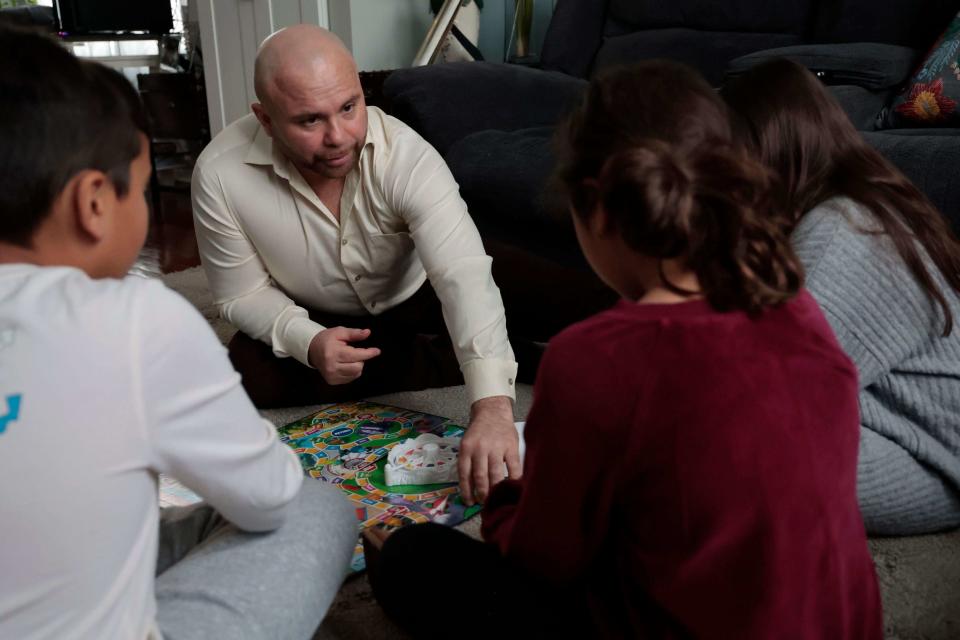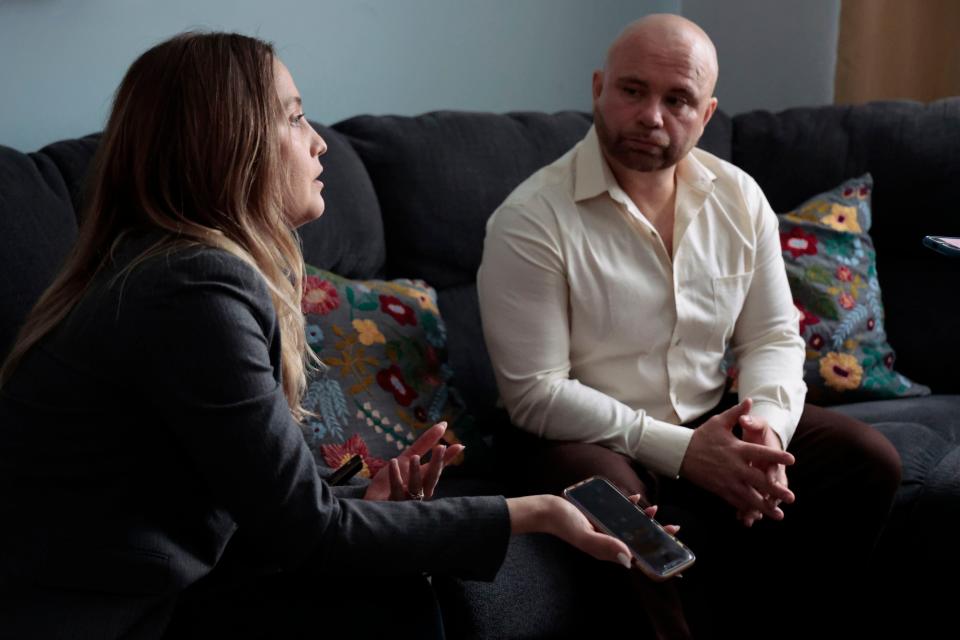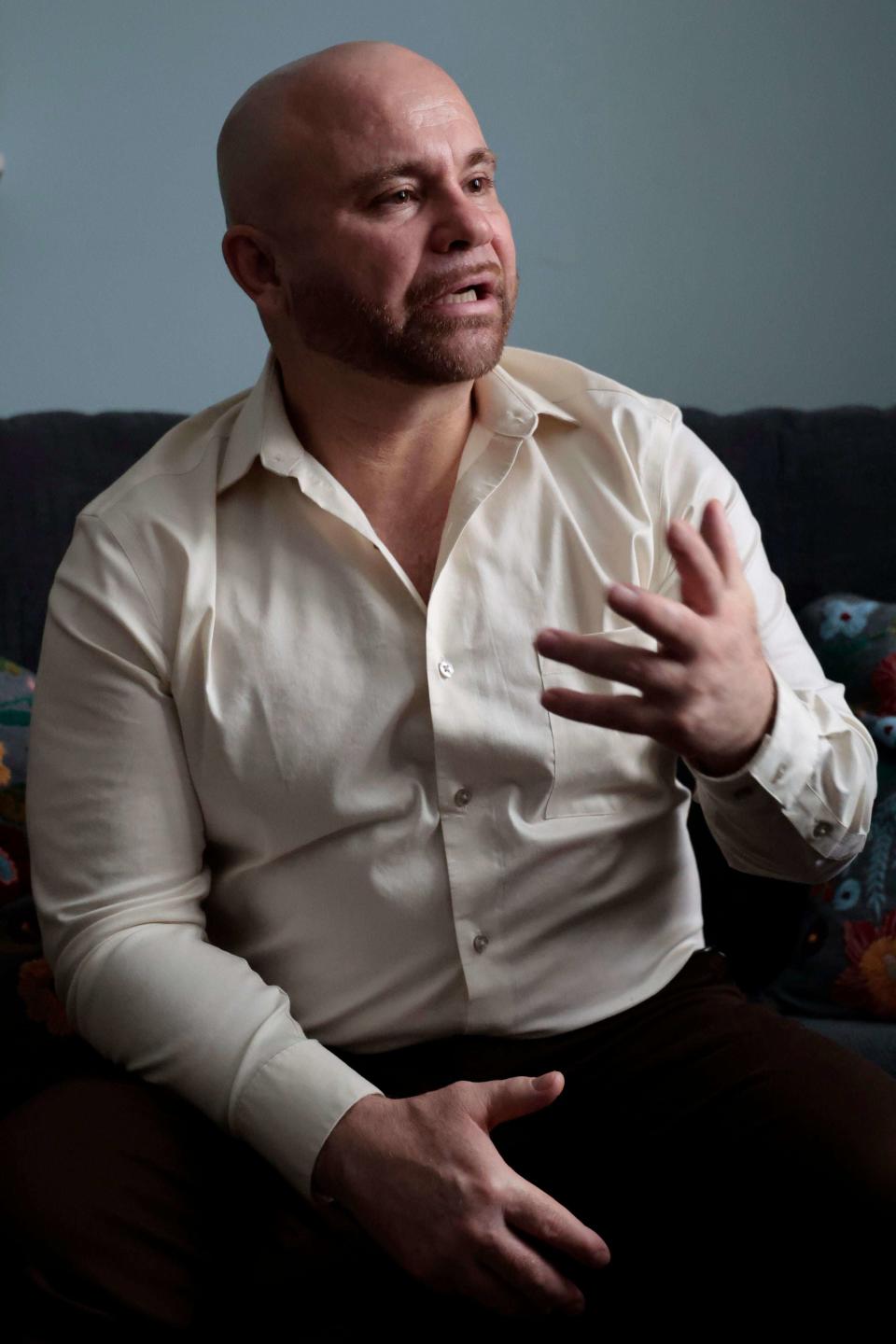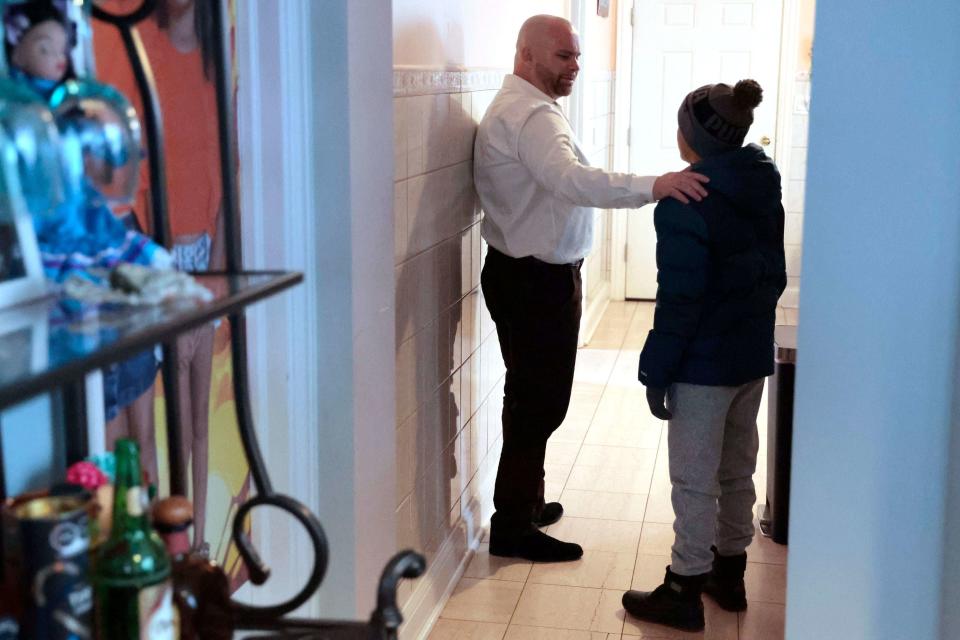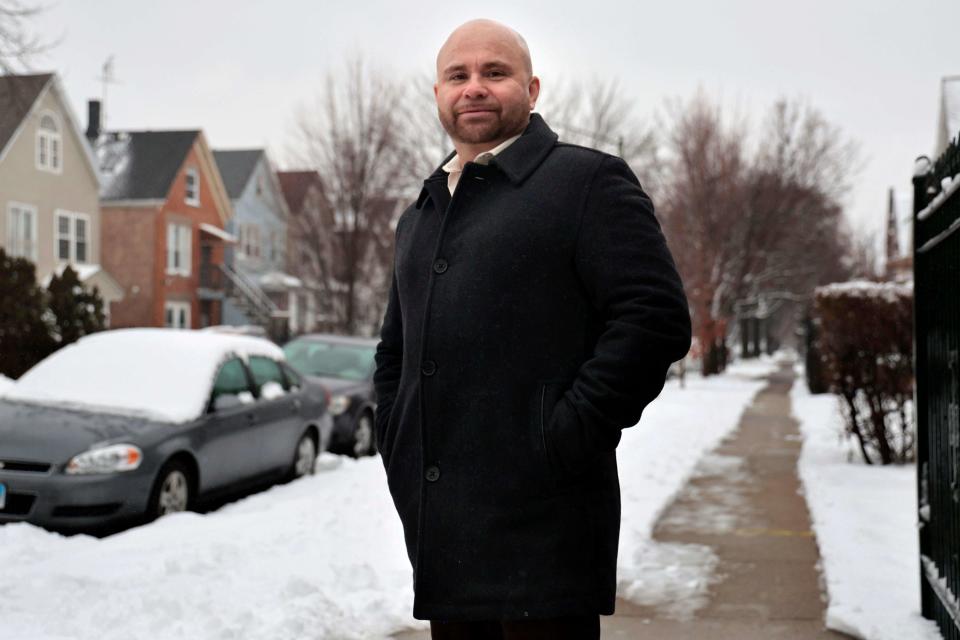Edgar Naranjo was freed after serving half of a 40-year sentence. Critics say his case shows what’s wrong with the felony murder law.
In 2002, Edgar Naranjo was a 26-year-old drug addict desperate for money. He hatched a plan to rob a flea market vendor he figured had a large supply of cologne he could unload for cash.
His haphazard scheme went badly awry. After Naranjo and a teenage accomplice broke into their target’s Northwest Side home, the vendor’s son, a Chicago police officer, shot and killed the younger intruder and wounded Naranjo, who was later arrested after seeking treatment.
For his role in the home invasion, Naranjo wound up with a 40-year prison sentence under Illinois’ felony murder rule, a controversial law that allows murder charges to be filed against a person committing certain felonies if someone is killed during the commission of those crimes.
But Naranjo caught a break. Halfway into his lengthy prison term, Naranjo was released in late October after being granted clemency by Gov. J.B. Pritzker.
Under changes made in the sweeping 2021 criminal justice reform bill known as the SAFE-T Act, Naranjo likely would no longer be eligible for a felony murder charge. Beyond that, Naranjo’s clemency petition highlighted issues related to the 2002 shooting detailed in a 2021 investigation by the Milwaukee Journal Sentinel that pointed to problems in the case that include conflicting narratives of the fatal shooting and also questioned the fairness of Naranjo’s sentence.
The petition noted that Rafael Balbontin, the off-duty police officer who shot Naranjo and his accomplice, was later convicted of stabbing his wife to death. Balbontin was sentenced to 25 years in prison, far less than the term handed to Naranjo.
In his clemency petition, Naranjo admitted wrongdoing and expressed remorse for putting his friend, 14-year-old Juan “Johnny” Salazar, in a situation that got him killed. But Naranjo’s lawyers argued in the petition that his punishment went beyond his role in the events that led to Salazar’s death.
“Yeah, you look at the facts. They tell you it’s not fair. We see all these things. But it’s not nothing new,” Naranjo, now 47, said in an interview with the Tribune earlier this month. “But at the same time, I’m OK with it. I don’t have no bitterness, no resentment, because it was just time that I used to better myself.”
Naranjo wasn’t the only person imprisoned in a felony murder conviction to be granted clemency last year. Pritzker also granted clemency to Gerald Berry, who was serving natural life in prison after being convicted of felony murder for his role as a lookout in a 2001 home invasion that led to the shooting deaths of one of his co-conspirators as well as a man they were seeking to rob. Berry, who was 20 at the time of the crime, will now be eligible for parole after serving 27 years.
A spokesperson for Pritzker, who has aligned himself with progressives on criminal justice issues, would not discuss the governor’s position on the felony murder rule, saying only that decisions to grant clemency are decided on a case-by-case basis.
“The clemency process involves a very careful review of the individual facts of each petition and the recommendation of the Prisoner Review Board,” Pritzker spokesperson Alex Gough said in a statement. “The Governor takes this responsibility very seriously and will continue his efforts to ensure that criminal justice lives up to the principles of atonement and rehabilitation.”
Naranjo’s case highlights issues critics point to in their opposition to the felony murder rule, versions of which are on the books in many states — several of which, like Illinois, have put curbs on the charge in recent years.
Steven Drizin, the co-director for Northwestern University’s Center on Wrongful Convictions and one of Naranjo’s attorneys in his bid for clemency, said the felony murder rule results in “dozens of others who are serving murder time at 100% for crimes that shouldn’t be charged as murder.”
“And Edgar’s case is probably the most extreme case of injustice in that a third party intervened in the crime and killed his friend, his accomplice. That can’t happen anymore in Illinois,” Drizin said.
Jonathan Masur, a law professor at the University of Chicago, said one impetus for the felony murder rule is the need to provide an outlet for public outrage when someone is killed during the commission of a serious crime, even if that anger is directed at someone who played a peripheral role in the victim’s death.
Masur, whose specialties include criminal law, argues felony murder calls for punishment that is out of proportion to a person’s actual crime.
“You should be responsible for what you do and your own actions, and you shouldn’t be responsible for other actions over which you had very little control and very little involvement,” Masur said. “It just completely divorces an individual’s own culpability and moral responsibility from the punishment that they receive.”
On the other side of the argument, David Crump, a law professor at the University of Houston Law Center, said a felony murder statute is, in general, appropriate and can remove an incentive for criminal suspects to perjure themselves or minimize their role in a crime in situations where they might try to avoid responsibility for someone’s death.
“A robbery where somebody dies is not just a robbery,” Crump said. “It’s more serious.”
In his clemency petition, Naranjo said he came up with the idea to rob a man who sold cologne from a flea market where Naranjo’s family worked as food vendors.
On Oct. 4, 2002, Naranjo and Salazar drove to the vendor’s home in the 3000 block of North New England Avenue in the Montclare neighborhood. They wore bright yellow rain ponchos and face masks. Salazar carried an unloaded BB gun purchased by Naranjo.
The two forced their way inside the man’s house after his wife answered the door when Salazar knocked. The man’s wife began screaming and Naranjo told her to “shut up” while Salazar pointed the BB gun at her.
The man who Naranjo and Salazar sought to rob came to his wife’s aid, striking Naranjo with a mop wringer. His wife yelled, “They have a gun,” in Spanish.
Balbontin, a rookie police officer at the time and the couple’s son, was in the basement. Hearing the commotion, he grabbed his service gun and ran upstairs. Naranjo and Salazar ran from the home. Balbontin followed them outside and yelled, “Chicago Police, freeze,” before opening fire eight times in their direction. Salazar was shot in the back while Naranjo’s right hand was hit, the petition said.
Balbontin also accidentally shot his father, the target of the robbery, in the right shoulder.
Naranjo picked Salazar up, helped him back to their car and took off, throwing the BB gun and yellow ponchos out of the car window. He drove to an industrial area and dumped Salazar’s body on a curb.
Naranjo went to an area hospital for treatment. Staff called police, and after initially making up a story about his wounds, Naranjo eventually confessed to the attempted robbery.
In his bid for clemency, Naranjo expressed regret, mostly for Salazar’s death.
“I am constantly overcome with guilt, shame and remorse over the pain that decision caused,” Naranjo said in his petition. “I will forever live with the pain I caused. Johnny was only 14 years old; he never got to live his life. He was a good friend to me, and I should never have agreed to take him with me.”
Reached by the Tribune, Salazar’s mother declined to comment. But she told the Journal Sentinel in 2021 that Naranjo should remain incarcerated and that she couldn’t forgive him.
“We all make mistakes,” she told the newspaper. But she said her son was treated “like an animal” by Naranjo, noting that he dumped his body “instead of taking him to a hospital, or, hell, bringing him home to me.”
Chicago police, prosecutors and Balbontin offered varying narratives of the incident, according to the clemency petition, which is partly based on testimony in a lawsuit filed by Salazar’s family.
The Chicago Police Department’s former longtime spokesperson, Pat Camden, initially called Balbontin’s actions “heroic” and said both Naranjo and Salazar had guns, and that a law enforcement panel concluded that the officer was “in fear of his life.”
A prosecutor at Naranjo’s bond hearing alleged that one of the intruders “turned and pulled the trigger several times, but the gun did not fire,” according to the petition.
At a later date, Camden slightly changed the department’s narrative saying Balbontin “saw one of the two with a gun.”
Balbontin testified in his deposition for the lawsuit that he never saw either of them holding a weapon and that he could not see their hands or arms because of the yellow ponchos they were wearing. He also testified that Salazar “jerked real quick and made a furtive movement” when he told him to freeze and then opened fire.
Naranjo’s legal team contended in his clemency petition there’s no evidence to back any of these narratives. For instance, Salazar’s autopsy showed that he was shot in the back, which the legal team argued is inconsistent with Balbontin’s account in one legal proceeding about the case that the 14-year-old turned toward him and was “crouching a little.”
“This new evidence not only demonstrates that the narratives of law enforcement kept changing, but it also raises questions about the Chicago Police Department’s quick decision to clear Balbontin and find that the shooting was justified,” the clemency petition states.
In the late 2000s, the city settled the Salazar family’s lawsuit for $2.25 million.
In addition to outlining the conflicting narratives of the shooting, Naranjo’s lawyers cited two changes within the SAFE-T Act, sweeping criminal justice reforms passed by the legislature in 2021, that they believed were pertinent to their client’s case.
One of the changes prevents prosecutors from using the felony murder rule in cases where third parties, such as police officers, intervene in certain crimes and kill co-conspirators. This change was not retroactive. Naranjo’s lawyers argued in his petition that if it were, felony murder likely would not have been an option.
The other change prohibits police officers from using deadly force against suspects fleeing from their felony crimes unless officers have reason to believe that they can’t be arrested later and that they’re likely to do harm to another person.
“Neither of these circumstances existed in Edgar’s case and today, Officer Balbontin’s shooting of Salazar and Edgar would be given much greater scrutiny and likely would not have been deemed ‘justified,’” the petition states.
Additionally, Naranjo’s lawyers argued in the clemency petition that his 40-year sentence was especially unfair considering Balbontin was sentenced to 25 years in prison after being convicted in the fatal stabbing of his wife.
In January 2005, Balbontin was out to dinner with his parents when he told them he was going home to kill himself, Naranjo’s petition says. When he left the restaurant, his parents called his wife and warned her of his threat, and suggested she hide all the guns at home.
But when he got there, the petition says, Balbontin got into a dispute with his wife and stabbed her repeatedly, killing her. He also stabbed his mother-in-law in the arm when she tried to intervene, but she survived.
“Edgar should not be required to serve more time for his less serious crime of an attempted home invasion than Officer Balbontin is currently serving for his brutal and senseless murder,” Naranjo’s petition says.
Naranjo was released from prison on Oct. 31 and spent the holidays getting to know cousins and nephews he’d never met. Thanksgiving was a big family celebration, about 20 people, in a relative’s living room. On Christmas Day, he and his parents, brother, sister-in-law and a nephew had Chinese food.
Flanked by Marissa Jackson, one of his lawyers, Naranjo said he wants people to understand that the person he was in 2002 no longer exists.
“That guy passed away,” Naranjo said. “I think the 21 years of spending time and just really paying attention to myself, I think that was the goal. You know, to really understand who I was ... as a person. My goals. My identity. Trying really to find an identity and a purpose.”
That purpose, he said, is finding a way to speak up for people who are still incarcerated but would be freed if sentencing reforms, like the change to felony murder, that have been passed by state lawmakers in recent years were retroactive. Efforts toward that end in recent years have been unsuccessful in Springfield.
“I think that we need a fair system,” Naranjo said. “I want to make it known that I’m still thinking about the brothers, the acquaintances, the people that were left behind in the same situation that I am. I think about them every day.”
